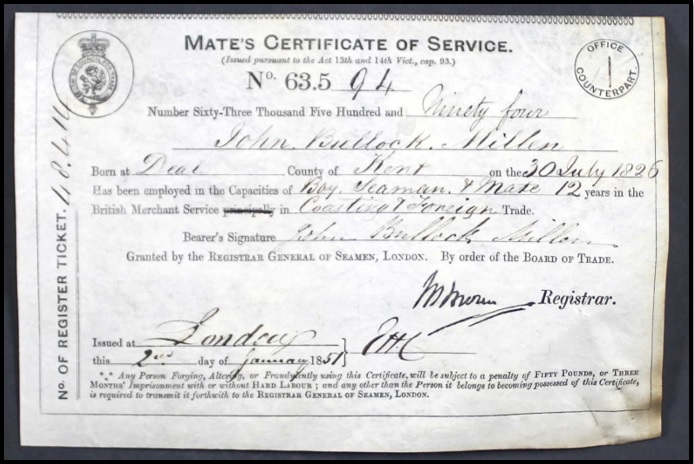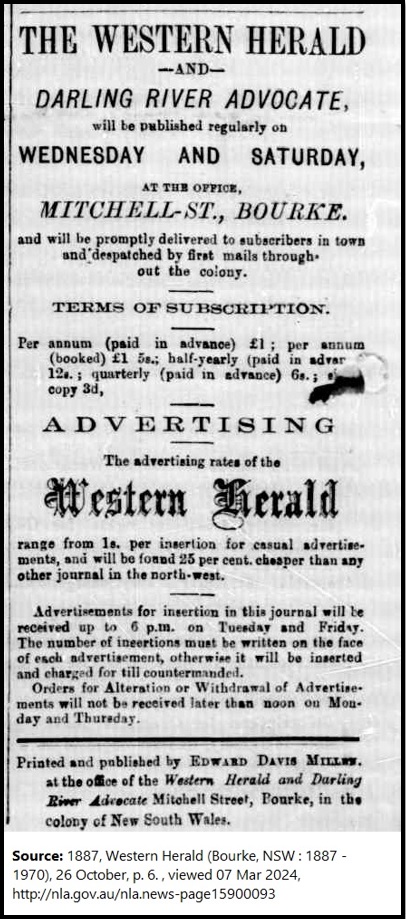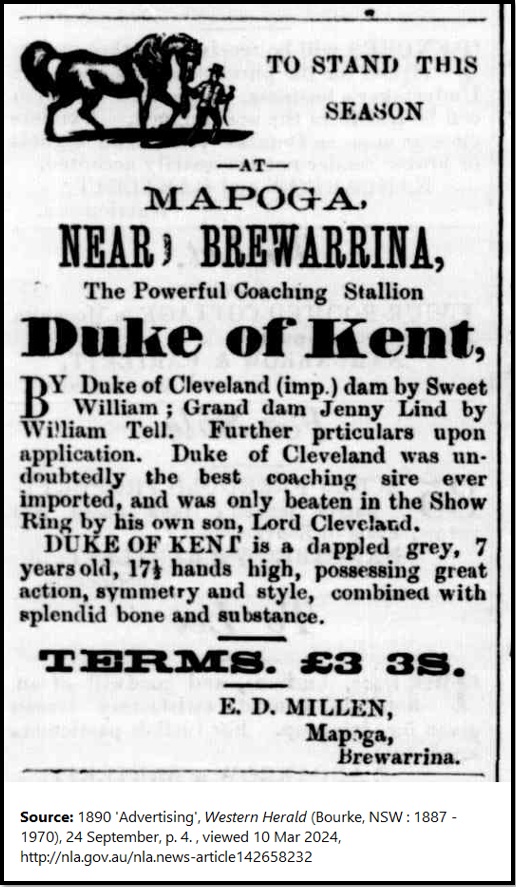Published on Tuesday, 26 March 2024 at 9:26:14 AM
Welcome to #TimeWarpTuesday! If you have ever wondered about the man behind the name of the heritage listed stately ‘mansion’ house that is known as Edward Millen House, then you will be in for a treat. The man himself was a man of adventure and passionate belief in providing our soldiers all they needed to return from World War I and integrate back into life as a civilian. Edward Davis Millen was a journalist, grazier, land agent, politician, senator, cabinet minister, husband, father, grandfather, patriot and friend to Australia’s soldiers. And contrary to popular opinion, he did visit Western Australia.
Edward Davis Millen (1860-1923)


Signature of Edward Davis Millen. Image taken from the first edition of ‘Repatriation’ the official journal of the Repatriation Department, Vol. 1, No. 1 (March 1919). Courtesy of Trove.
-Part One-
Birth and Early Life
Edward Davis Millen was born on 7 November 1860 in Deal, Kent, England. His parents were John Bullock and Charlotte MILLEN (nee DAVIS), and he was the fourth of eight children born to the couple.

John Bullock MILLEN’s ‘Mate’s Certificate of Service’
UK and Ireland, Masters and Mates Certificates, 1850-1927, Courtesy of Ancestry.com.au
Edward’s father, John Bullock MILLEN was a Pilot of the Cinque Ports, by trade. A ‘pilot’ here being the name of an old occupation, in which the holder ‘steered ships or boats’ [1]. John MILLEN’s ‘Mate’s Certificate of Service’ dated 2 January 1851, states that he had been employed in the capacities of Boy, Seaman, & Mate for 12 years in the British Merchant Service in Coasting & Foreign trade. The early years of Edward’s life were thus firmly tied to the sea and trade, with his paternal grandfather, Charles MILLEN (1790-1869) also working as a Pilot of the Cinque Ports [2] and later a Warden of the same.
Interestingly the motto of the town of Deal, where Edward was born, is “Adjuvate Advenas” [3] meaning “Befriend the Stranger”. Deal was a very busy port during the time of the sailing ship as the port offered a place for ships to wait safely till the winds changed and they could continue their journey onto London. However, a lot of ships were also wrecked along the coastline and there was a long history of visitors to the little town, be they weary ocean going travellers or merchant seamen trading their goods. There would have been a strong sense in the community of the town’s motto “Befriend a Stranger”. The work that Edward would do in his life especially later when he became Australia’s first Minister for Repatriation, strongly reflects this motto and the ethic of his birthplace, for he was known by returning soldiers across the country as a ‘friend’ [4].
Migrating to Australia
Records show that Edward was working in marine insurance in England until around 1880 when at the age of around 20 years [5], he immigrated to New South Wales [6] . As far as is known, Edward came alone, but his older brother Ernest Charles MILLEN, would later follow in his brother’s footsteps and moved to New South Wales in 1882.
Love and Marriage
Upon arriving in New South Wales, Edward decided to try his luck on the land and worked as a station hand around Walgett, where he met Constance Evelyn FLANAGAN. Edward and Evelyn married in Bourke on 19 February 1883 [7]. The couple took up the lease of a property named ‘Mapoga’, which was situated along Cato Creek, some ten km from Brewarrina.
On the 6 June 1884 the Millen’s were blessed with the birth of a son they named Edward Eugene MILLEN, but sadly he lived only 3 weeks, dying on the 27 June 1884.
A Grazier and Land Agent in Bourke and Brewarrina
Edward ran horses and sheep on his property and his registered stock brand [8] that could be used on either horses or cattle was an upside-down capital letter “Q”. This is curious as most stock brands consist of initials of the property owner, or even the first few letters of their property name, however it seems at the present time a mystery lost to the pages of history, as to why Edward chose the letter “Q” for his brand.

Extract from ‘First Quarterly List of Horse and Cattle Brands for 1884’ in the Supplement to the New South Wales Government Gazette, showing the registered stock brand owned by Edward. Courtesy of Ancestry.com
By 1887, Edward also had property and interests in Bourke. He was a very astute businessman who invested in and actively promoted schemes that would benefit the local community, such as the ‘Bourke Chilled Meat Supply and Export Company Limited’ [10], that aimed to assist the local graziers of Bourke and surrounding districts to better compete with the meat markets of Sydney. It was around this time that Edward would get his first taste of politics as “he was nominated as a delegate to be sent to Sydney to petition the Minister for Works for a railway line and bridges on the back creeks.”[11]
During the late 1890s Edward had “set up as a land, mining and financial agent; by 1902 he had an office in O’Connell Street, Sydney, and a house at Burwood.”[12] Edward would spend a fair amount of time travelling between his properties around Bourke and Brewarrina and also to Sydney and Melbourne following Federation in 1901. He was however a man committed to the betterment of Australia and creating opportunities for others to grow and succeed so travel did not faze him.
Newspaper Career
During his time in Bourke, Edward worked for a local newspaper, by 1887 he had established, and edited the Western Herald and Darling River Advocate.

Flood
In true Dorothea Mackellar style [13], the “flooding rains” poured down in Queensland in 1890 and in April, New South Wales was being barraged with rain and the rivers were filling and flooding fast. Edward’s property Mapoga was situated along the banks of Cato Creek, a tributary of the Darling River. The Barwon River’s banks were gushing as it flowed into the Darling River between Bourke and Brewarrina. “The Darling River is 1,472 km long but when including its tributaries, stretches to 2,844 km. It drains all of New South Wales west of the Great Dividing Range. And when it floods the pain is felt everywhere. …Bourke’s hospital and jail were cleared. Women and children were packed onto trains and sent to safety while the rails were still intact. Bourke’s steamer was busy shunting people to higher ground. Horrified residents watched as sheep, cattle and horses floated past the town from the cataclysm upriver.”[14] With the rising of the Darling River, so its tributary, Cato Creek burst its banks also causing a large loss of property and livestock, but thankfully no loss of life. Edward and Evelyn were however to have a close call in the floods of 1890, and no doubt the memory of their waterlogged adventure would have stayed with them for a very long time. A newspaper of the time reported the story:
“Reports are to hand of terrible suffering and loss of stock at Brewarrina. The following is the latest:- The river has now fallen 16in., but the water is still in the main street. Business is being resumed at the banks and stores and comparatively speaking little damage has been done to the town itself. There has been a gratifying immunity from serious or fatal accidents. From reports to hand, however, there have been very heavy losses of stock and damage to property in the immediate vicinity. On the 17th inst. [April 1890] A report reached here that the Aboriginal mission station, 10 miles above Brewarrina, was in danger, A volunteer rescue party at once started, reaching there the same day, finding the station surrounded by water, but the inmates were safe. Next day the boat proceeded across country to the Cato [Creek], and visited the homesteads of Messrs. Thomas Richards, William Shearer, and E. D. Millen, all of which they found apparently recently deserted and the water running through the premises. At Shearer’s place they saw several hundred sheep which had been drowned. The party then proceed to the homestead of Mr George Harden, where they found Mr. and Mrs Millen and another lady, together with a station hand, who had arrived there a short time before. This party made a start from Mapoga on a raft, built with planking on two iron tanks, on Thursday evening, the 17th inst., at 4 o’clock intending to get down stream as far as Harden’s selection, a distance of some four miles. When they had proceeded some distance they were overtaken by night, and as they did not consider it safe to go on in the darkness they made the raft fast on a tree, remaining there till morning, when they made another start and landed on a small island, from whence Mr Millen made his way through the water to Harden’s selection, procured a buggy and pair of horses and returned for the rest of the party. He took them down to Harden’s selection, reaching there at about 9 p.m. on the 18th, after 30 hours’ exposure. The ladies of the party, together with Mrs. George Harden, jun., were brought to town next day by a boat sent out for that purpose. Mr Millen is a heavy loser by the flood, as about 2000 ewes, together with their lambs, were drowned.” [15]
Edward no doubt thanked the skills he would have learnt in his early childhood years growing up in Deal, Kent and through his strong familial ties to the sea. It is imagined that Edward went quite calmly mid the danger of the rising flood waters to strap planking across two tanks and creating a raft to facilitate escape.
But life on the land goes on, and the seasons turn, thankfully Edward and his family were able to continue working and living on Mapoga.
Advertising in Edward’s own newspaper in late September of 1890, roughly five months after the floods, shows that life on Mapoga must have been returning to normal with signs of a new business in horse breeding being attempted.
Edward and Evelyn were blessed with the births of two more children, daughters, Jessie in 1891 and Ruby in 1893. These two children would grow up to marry and have two children each, making a total of four grandchildren for the Millen’s.

-End of Part One-
We hope you have enjoyed the first half of our look back at the life and achievements of Edward Davis Millen. Be sure to check back next week for Part Two, and the Western Australian connection of this little known Australian.
We are always keen to collect photographs, memorabilia, and other items related to the history of the suburbs within the Town of Victoria Park and can scan and return originals to you. If you have something you’d like to share, please reach out. You can get in touch with us via Ph: 08 9373 5500, E: vicparklibrary@vicpark.wa.gov.au, or by coming in.
#LoveVicPark #VictoriaParkDictionaryofBiography #EdwardDavisMillen
Footnotes:
[1] Hewitt, Jane and Hewitt, Paul Jack 2009, ‘Dictionary of Old Occupations’, Family Researcher, accessed online 06/03/2024, https://www.familyresearcher.co.uk/glossary/Dictionary-of-Old-Occupations-Index.html
[2] Deal is a coastal town in Kent and is member of the Cinque Ports, “a confederation of historical ports which, for hundreds of years, provided ships and sailors to defend England’s coast against invaders in return for special privileges from the Crown.” (https://cinqueports.org/). The word ‘Cinque’ is French for ‘Five’ and refers to the original five towns who were members of the confederation. They were also the closest ports to France.
[3] ‘Deal’, The Cinque Ports, website, https://cinqueports.org/deal/, accessed 7 March 2024. And Deal Town Council, Deal Town Council, website, https://www.deal.gov.au , accessed 7 March 2024.
[4] 1923 'A FRIEND OF THE SOLDIERS.', The Advertiser (Adelaide, SA : 1889 - 1931), 17 September, p. 12. , viewed 09 Mar 2024, http://nla.gov.au/nla.news-article37206496
[5] Edward’s birthday being later in the year makes it possible that he may have travelled to New South Wales at only 19 years of age.
[6] Payton, Philip 2018, Repat’ : A Concise History of Repatriation in Australia, Department of Veteran’s Affairs, Canberra, p. 24.
[7] Rutledge, Martha 1986, 'Millen, Edward Davis (1860–1923)', Australian Dictionary of Biography, National Centre of Biography, Australian National University, https://adb.anu.edu.au/biography/millen-edward-davis-7577/text13227, published first in hardcopy 1986, accessed online 10 March 2024.
[8] New South Wales Government 1884, ‘First Quarterly List of Horse and Cattle Brands for 1884’ in the Supplement to the New South Wales Government Gazette, No. 337, 10 July 1884, p. 4665, Accessed online via Ancestry.com.au.
[9] Ibid.
[10] 1890 'Advertising', Western Herald (Bourke, NSW : 1887 - 1970), 8 October, p. 3. , viewed 10 Mar 2024, http://nla.gov.au/nla.news-article142658659
[11] Marrickville Unearthed 2019, ‘Marrickville’s First Political Giant’, Marrickville Unearthed, website accessed 10 January 2024, http://www.marrickvilleunearthed.com/2-woodcourt-st.html
[12] Ibid.
[13] Dorothea Mackellar wrote the famous Australian patriotic poem “My Country” in 1904 (when it was originally called ‘Core of My Heart’). The poem includes the well-known lines “I love a sunburnt country, a land of sweeping plains, of ragged mountain ranges, of drought and flooding rains. I love her far horizons, I lover her jewel-sea. Her beauty and her terror- The wide brown land for me!’…” an apt and oft quoted description of the extremes of Australian weather and her wild, untamed majestic beauty.
[14] Marrickville Unearthed 2019, op. cit.
[15] 1890 'THE FLOODS ON THE DARLING.', The Daily Telegraph (Sydney, NSW : 1883 - 1930), 28 April, p. 5. , viewed 10 Mar 2024, http://nla.gov.au/nla.news-article235721712
Back to All News